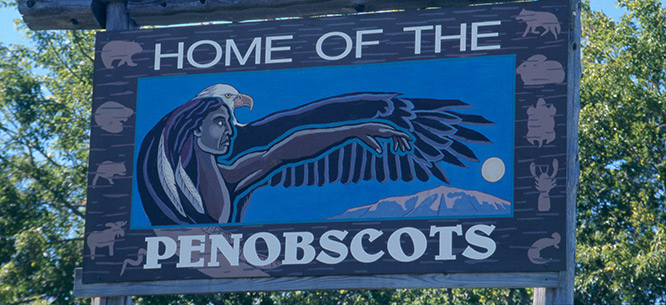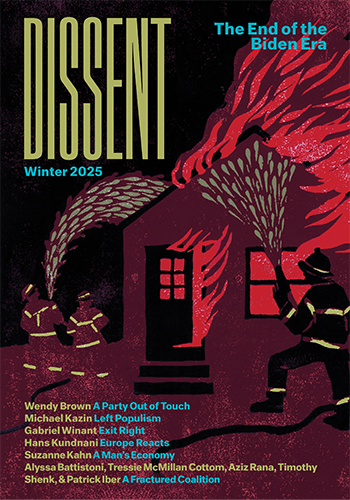Restorative Justice in Indian Country
Restorative Justice in Indian Country
Wellness courts provide an example of how some tribal governments are using indigenous sovereignty to build a community-based justice system, rooted in support and trust rather than punishment.

When Kris Loring stepped into the Penobscot Nation’s Healing to Wellness Court on Indian Island in Penobscot, Maine, around four years ago, he immediately felt the difference.
“It definitely wasn’t like a regular court,” he said. Attending his hearing was like “sitting down in a big living room. . . . You’re all right in a circle, wherever you want to sit.”
Loring volunteered for the alternative treatment court after a drug-related prosecution involving a local meth lab. He had been struggling with addiction for years, and he was keen to change his life. He spent the next year following the court’s prescription for healing: learning his tribe’s language, making drums, attending sweat lodges, and meeting several times a week with a substance abuse counselor. He also regularly gathered in the semicircle with other participants who were working through their own treatment plans. It was a world away from the treatment regimen that a regular state court would have mandated under the threat of incarceration; there, he said, “they probably would have just thrown me away.” Most people he knew who had been placed in the state program never made it through.
“You need a place that’s not going to treat you like an animal [and will] treat you like a human,” Loring said. “I think that’s what the difference was between the program they have on the island and the regular state program—the way they treat you.”
This wellness court is an example of innovations in justice that some tribal governments have created to oppose two disturbing trends: Native Americans are disproportionately vulnerable to violent crime, and they are also more likely to caught up in a criminal justice system that fails to serve their communities’ needs for security and social stability. Indian Country courts have always been isolated from the rest of the country’s judiciary. While that legal separation has been a source of disenfranchisement and inequity for generations, it is now a platform for asserting indigenous sovereignty and rethinking community-based justice.
Tribal wellness courts are roughly structured like drug courts, which, at least in theory, are supposed to focus on rehabilitation as an alternative to incarceration. Wellness courts mostly deal with conventional drug- and alcohol-related charges, but with a focus on diverting people from incarceration and offering a culturally driven treatment framework. While drug courts have often been criticized for being more punitive than therapeutic—frequently threatening individuals with jail if they fail to comply with their treatment plans—the wellness court has an unusual mandate: the judges, counselors, and social service providers who run the court emphasize support and trust rather than punishment, and use ancestral cultural practices to help people in treatment rebuild their lives and integrate into the community.
The network of more than ninety wellness courts nationwide is part of a project of court reforms since the late 1990s that mesh Native culture with principles of rehabilitation and restorative justice.
Joseph T. Flies-Away, a former chief justice in the Hualapai Tribal Court who has helped establish wellness courts in other tribal communities, said tribes are incorporating ancestral traditions in their legal institutions to develop therapeutic systems of accountability. Though the wellness courts are based on drug courts promoted by state and federal governments, he said, “I always thought of it as going back to something and reigniting something that we should know how to do.”
Ron Whitener, a retired chief judge for the Tulalip Tribes in Washington and now a consultant on tribal law, said that while regular criminal courts may direct an individual to seek treatment and never follow up, “healing to wellness courts say, ‘Alright, you pled guilty. . . . Here are the things you need to do; here are the people that you can call if you’re having trouble. If you need some strategies, we’ve got somebody who knows housing issues, we’ve got a mental health person you can talk to. You basically try to provide a support group for everything that they’re doing that can bring them back to being a productive person.”
A wellness court usually accepts voluntary participants through a referral from the criminal court system, though in some cases a spot is granted to individuals who have not been convicted but who want a structured rehabilitation program. Participants must be enrolled in a federally recognized tribe and agree to a social contract in which they pledge to devote themselves to the recovery plan (often while serving out probation under the oversight of a criminal court).
At the Penobscot court Loring attended, recovery is structured around four stages: east tobacco (introduction to the program), cedar (taking responsibility for the substance use disorder), sage (treatment), and sweetgrass (“making a difference for yourself, your family, your community, and the Penobscot Nation”).
In the semicircle that formed around Loring at each weekly court meeting, he was joined by members of a holistic treatment team, including a substance abuse counselor, cultural advisers, and housing, health, and education experts. Also present were representatives that would be present in a regular court, including a judge, the tribal public defender, the tribal prosecutor, and police officers. Chief Judge Eric Mehnert, who helped design the court along with the community members who staff the system, sits outside of the semicircle at the front of the courtroom. “Most of the time when people had been in front of the court, they had been told that they’ve done something bad and that they were going to be punished for it,” he said. “And I thought that they deserved to have an authority figure tell them, ‘You’ve done something great, and I want to really commend you for it,’ and have the full weight of that authority behind it.”
The wellness court still retains some features of a conventional drug court—the judge could detain someone briefly in a local jail if they have a severe relapse. But Mehnert said he has not jailed anyone in two years. A former civil rights lawyer (and not a Penobscot member), he said he tries to make the treatment as proactive as possible, usually applying graduated sanctions depending on the stage of the process. Initially, there will be regular drug testing, and if a participant is caught using drugs or alcohol their first punishment will be minor: Mehnert will ask for a written self-reflection on what triggered the relapse, or they might be assigned to some kind of community service, like working at a food bank. Later in the plan, work and other recreational activities are introduced. “We work from that external locus of control. . . . to an internal locus of control, where the individual is actually taking control and taking responsibility for their own actions,” Mehnert said.
Loring, who went through the program along with his brother (who was arrested with him), recalled how the purification ceremony of a sweat lodge helped him process childhood trauma from growing up in a family rife with drug and alcohol problems. Undertaking a sweat alongside peers, he said, can “bring you in touch with yourself. . . . It gives you that time to see where you went wrong and try and make it right somehow.”
The Saint Regis Mohawk wellness court in Akwesasne, New York, tries to encourage recovery through positive connections and provides techniques for dealing with personal as well as historical trauma. That might include participating in a men’s group chat or learning how to fashion tribal regalia. In contrast to drug courts that process dozens of cases at a time, Chief Judge and tribal member Carrie Garrow said, “We’re able to take a little bit more time. And we really focus [on telling] our participants: ‘We need you to be healthy . . . whatever you want to contribute to your family and the community, we need that talent, we need that skill, we need you to be a good mom, a good dad, if you have kids now, or when you have kids in the future.’”
The wellness court system is one way that tribal governments are bolstering their legal infrastructure and asserting sovereignty. For decades, tribal jurisdiction has been entangled in a patchwork of federal and state authorities, which often deprive tribal governments of the ability to prosecute crimes perpetrated by non-Native people on their lands. Under the Obama administration, federal reforms expanded the powers of tribal courts for certain domestic violence cases involving non-Native defendants, but tribal courts remain heavily restricted in the kinds of cases they can try—they cannot, for example, try cases of sexual assault or child abuse involving a nontribal defendant.
Nationwide, Native Americans experience extraordinarily high rates of violence compared to their white counterparts, particularly intimate partner violence. They also suffer from some of the highest rates of substance-use disorders. Poverty and unemployment feed social instability and distress. And in recent years, a high number of killings and disappearances of indigenous women has been documented in both the United States and Canada.
Native Americans are also disproportionately targeted by police. According to the Lakota People’s Law Project, based on federal data from 1999 to 2011, Native Americans were more likely than Black, Latinx, Asian, or white Americans to be killed in police shootings. Native American youth are significantly more likely to be arrested than their white peers, and in states with sufficient data, they tend to be sentenced to adult prisons more often than their white peers. Native men and women are incarcerated at rates four and six times higher, respectively, than their white peers.
While the wellness court model represents a rehabilitative response to these patterns, some tribes, by contrast, are building out their legal infrastructure for punishment. Jail building on tribal lands has accelerated in recent years, with the support of federal funding. Between 2000 and 2018, according to the Bureau of Justice Statistics, the number of jails on tribal territories grew by some 24 percent, with the largest jails in Washington State (Nisqually Tribe), Arizona (Gila River Indian Community) and South Dakota (Rosebud Sioux Tribe). During the same period, the number of Native Americans employed by jails grew by more than a third, while the jail population, which is relatively small, has gone from an estimated 1,775 people to 2,870.
Some tribal justice advocates interviewed for this article argue that jails should be built on tribal lands because these areas are starved of law enforcement resources, and tribal members should be able to be detained closer to their families and to community-based services. Whitener said facilities for some form of detention are necessary, “but they need to be places where people can rehabilitate and be productive, and they shouldn’t be places of just punishment. Otherwise you’re just going to get somebody more broken at the end of their incarceration term, which doesn’t help anybody.”
Gabe Galanda, an indigenous rights lawyer of the Round Valley Indian Tribe and chair of Huy, a support group for incarcerated indigenous people, argues that because tribal governments and courts have been underfunded for years, tribes are seeking “basic funding for the most basic law enforcement services.” Jails are necessary, he told me, in order to detain people who have been arrested on serious charges. Nonetheless, Galanda added, given the relationship between mental health problems and law enforcement encounters on tribal land, “We need to apportion way more dollars to mental healthcare than we are affording it, even if that means taking some of those dollars from prison or police programs.”
Chase Iron Eyes, lead local counsel with Lakota People’s Law Project and a member of the Oglala Nation, said that in communities like his, the Pine Ridge Reservation, where social services are chronically underfunded, jail building has been “a double-edged sword,” which only underscores the deficits in other aspects of the social infrastructure. “Yes, you’re getting this development. You definitely need this tribal jail or this justice center because you don’t currently have it. But you also don’t have a new school. You don’t have a new hospital. You don’t have a youth center. . . . I would want there to be equal investment in other areas of preventive efforts.” Law enforcement funding was the largest single allocation in the 2020 Bureau of Indian Affairs budget, at more than $395 million—more than double the funding for human services programs.
Iron Eyes noted that tribal justice traditions do allow for some forms of punishment. But if tribal governments are building jails to modernize their legal infrastructure, he said, they “also need to recognize that the purpose and the origins of the carceral system was to continue to subjugate African Americans post-slavery and to ensure that there was a labor force whose labor could be exploited, and that the criminal justice system is designed to provide for that labor source and for a place where those private profit interests can be had.”
A court system focused on rehabilitation can still only address the legal fallout of generations of social disinvestment and structural violence; it can’t tackle the intersecting crises of mental health, poverty, and drugs that have shattered so many lives in tribal communities. The social problems that pervade Indian Country, Iron Eyes said, are a product of “genocidal policies, which are doing exactly what they’re designed to do.”
Having worked in the administration of the Hualapai Nation (which does have a jail), Flies-Away said that there is a practical need for detention as a function of government. “But at the same time, we need to figure out what’s going on with these people. Why are they creating havoc and causing problems . . . acting like they ‘have no relatives?’”—a traditional phrase to describe destructive behavior. In confronting the roots of those problems, a path to healing can be an alternative to punishment. “The wellness side,” he added, “the ability . . . to contribute to your people, yourself, your tribe, and society—is way more important to me.”
For all its therapeutic successes, wellness court remains a reactive institution, catching people before they spiral further into the criminal legal system. But for individuals like Loring, participating in the program has helped him stabilize and rebuild his relationship with his children, which was sundered after his arrest—and the real healing took place when his family reunited.
Michelle Chen is a member of Dissent’s editorial board and co-host of its Belabored podcast.




